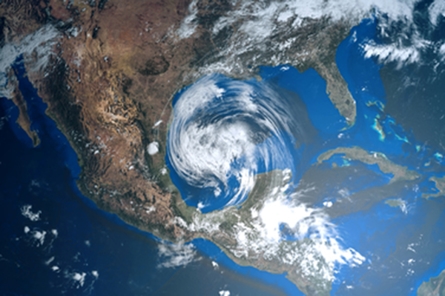
When a hurricane watch or warning is issued, it’s important to know what each hurricane category means. That way, you can know how much wind and water to expect, and how you’ll need to prepare for the oncoming storm. While a hurricane category may not be able to predict everything about an approaching storm, a category can provide a good indication of how the hurricane might affect a local area.
Use this helpful information from the experts at ServiceMaster Restore to learn about the different categories of hurricanes and prepare for hurricane season.
The Saffir-Simpson Hurricane Wind Scale
The National Hurricane Center (NHC) uses the Saffir-Simpson Hurricane Wind Scale to measure a hurricane’s sustained wind speed. According to the NHC, the scale was developed by wind engineer Herb Saffir and meteorologist Bob Simpson. The scale provides examples of the type of damage and impacts associated with the winds in each intensity. Meteorologists use the scale to assess the potential magnitude of a hurricane's impact to help residents prepare their homes and businesses ahead of time. Unfortunately, the scale doesn’t currently measure the likelihood of dangerous storm surges and catastrophic rainfall.
Learn the breakdown of the hurricane categories and the risks associated with each below:
Category 1
With winds ranging from 74 to 95 miles per hour, a Category 1 hurricane can produce some damage to a property, including damage to the roof, shingles and gutters. Damage to power lines and poles may also occur, causing power outages that could potentially last for days. Dangerous winds could destroy older mobile homes, and falling debris could cause injury to people and structures.
Category 2
A Category 2 hurricane has winds ranging between 96 and 110 miles per hour, which brings a greater risk of injury to people and structures. Strong winds and falling debris, including uprooted trees, can cause major structural damage to your home. After a Category 2 hurricane, residents can expect power outages that can last from several days to several weeks.
Category 3
During a Category 3 hurricane, devastating damage to properties will most likely occur. With winds between 111 and 129 miles per hour, even well-constructed homes or buildings may incur extreme damage. Uprooted trees could leave roads blocked, and electricity and water might not be available for weeks after the hurricane has passed.
Category 4
A Category 4 hurricane has a wind range from 130 to 156 miles per hour, and the storm can cause catastrophic damage. Flying debris can pose a significant risk of injury or death, and some homes may completely collapse. Roofs can blow off, exterior walls could be removed and other serious damages can occur. The hurricane may blow out windows on high-rise buildings and uproot most trees. Power outages and water shortages can be expected after a Category 4 hurricane, and the area may be uninhabitable for weeks to months afterward.
Category 5
The highest category available, a Category 5 hurricane has winds of 157 miles per hour or greater. People will be at serious risk of injury or death due to flying debris. A high percentage of homes and buildings may be destroyed, as total roof failure and wall collapse can occur. Commercial properties may receive significant damage, and metal buildings may collapse. As with a Category 4 hurricane, residents should expect long-term power and water outages, and the area will be uninhabitable for months after the storm.
How to prepare for a hurricane
If you live in a hurricane-prone area, take the necessary steps ahead of time to keep your family prepared. First, learn the truth behind some of the most common hurricane myths. Then, stock up on emergency supplies that can sustain you for three days or longer if you need to wait out the storm. Finally, when a hurricane watch or warning is issued in your area, find out which category the hurricane will be so you can prepare as best as you can.
If your home has been impacted by any hurricane category, call the experts at ServiceMaster Restore. Our hurricane and tropical storm damage services move fast to help get your life back on track. Available 24/7 every day of the year, we’ll be there for you with the guidance, support, knowledge and expertise needed to help you throughout the restoration process.
